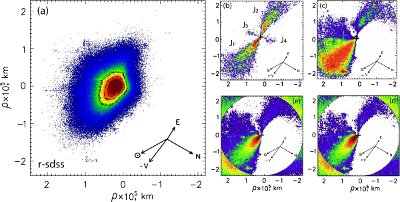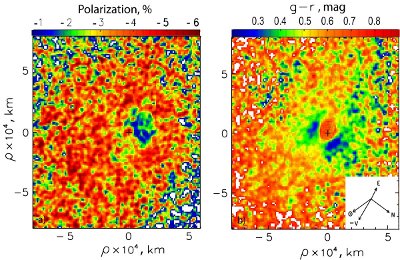|
The study of the optical, physical, and chemical properties of dust
from small bodies in the Solar system helps us to understand the main
mechanisms of their formation and evolution in the protosolar nebula.
For many hyperactive distant comets, as well as in the case of
C/2011 KP36 (Spacewatch), super volatile components, in particular,
CO2, are the main sources of the matter removal from the
nucleus surface. Sublimation of super volatile components can lead
to the ejection of a significant volume of water ice from the surface
of the comet`s nucleus, which subsequently, sublimating in the comet`s
coma, provides a large proportion of H2O in the total amount
of gas produced by the comet.
Complex polarimetric, spectroscopic, and photometric observations of
distant comet C/2011 KP36 (Spacewatch) were carried out at the 6-m
SAO RAS telescope using the SCORPIO-2 focal reducer. The comet was
active at a heliocentric distance of 5.06 AU.
In the cometary coma, 4 jets were found, which, as shown by modeling,
were formed by three active areas on the nucleus. This is already the
third distant comet studied by the authors at the 6-m SAO RAS telescope,
in which the spectrum is CO+ emission rich at a heliocentric distance of
more than 5 AU. Photometric studies have shown that the comet has a large
nucleus with a diameter of about 53 km. The modeling, based on the
analysis of photometric and polarimetric data, indicates a significant
activity of the nucleus with the predominance of numerous small active
regions on its surface (except for three large ones) which are
characterized by the release of various combinations and an abundance
of water, CO2 ice, and a refractory component.

Fig.1.
Image of comet C/2011 KP36 (Spacewatch) obtained with SCORPIO-2 at
the 6-m SAO RAS telescope using the r-SDSS filter (on the left) and
the results of reducing this image using the digital filters (on the
right). The jets associated with the active regions of the nucleus are marked.
|

Fig.2.
Distribution of the linear polarization in the r-SDSS filter (on the left)
and color (g - r) (on the right) along the cometary coma of C/2011KP36
(Spacewatch) according to observations on November 25, 2016.
|
Published:
Ivanova O., Rosenbush V., Luk'yanyk I., Kolokolova L., Kleshchonok V.,
Kiselev N., Afanasiev V., Kirk Z.R. Observations of distant comet
C/2011 KP36 (Spacewatch): Photometry, spectroscopy, and polarimetry,
2021, A&A, 651 (A29). doi.org/10.1051/0004-6361/20203
Contact - Ivanova O.,
DSc, Senior Researcher in Department of Interplanetary Matter in
Astronomical Institute of Slovak Academy of Science
|

